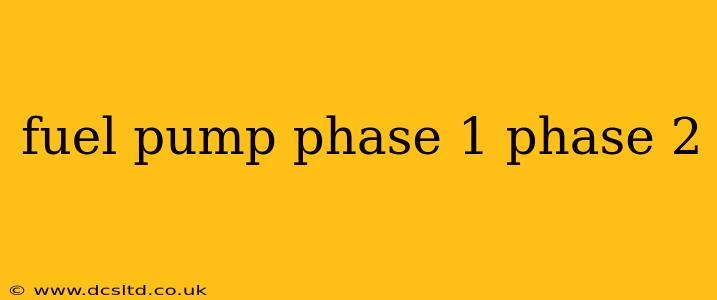Modern fuel systems, particularly in fuel-injected vehicles, utilize a sophisticated process to deliver fuel efficiently and reliably. This process often involves distinct phases, typically referred to as Phase 1 and Phase 2. Understanding the differences between these phases is crucial for diagnosing fuel delivery problems and ensuring optimal engine performance. This guide will break down the concepts of Phase 1 and Phase 2 fuel pump operation, clarifying their roles and how they contribute to a well-functioning engine.
What is Phase 1 Fuel Pump Operation?
Phase 1 typically refers to the initial priming stage of the fuel pump. When you first turn the ignition key (or press the start button), the fuel pump activates for a brief period. This initial burst isn't meant to sustain fuel delivery during engine operation; instead, its purpose is to:
- Pressurize the fuel lines: This builds up the necessary pressure in the fuel system, ensuring a steady flow of fuel once the engine starts.
- Fill the fuel rail: The fuel rail is the component that distributes fuel to the injectors. Phase 1 ensures the rail is filled with fuel, ready for immediate injection when the engine cranks.
- Check for leaks: The initial pressurization helps detect any leaks in the fuel system. If a significant leak exists, the pressure won't build appropriately, potentially preventing the engine from starting.
The duration of Phase 1 varies depending on the vehicle's make and model, typically lasting only a second or two. It's a crucial preliminary step, preparing the system for the sustained fuel delivery required during engine operation.
What is Phase 2 Fuel Pump Operation?
Phase 2 represents the main fuel delivery phase. This phase is activated once the engine starts and continues as long as the engine is running. The fuel pump operates continuously during Phase 2, providing a consistent supply of fuel under pressure to meet the engine's demands.
The pressure required during Phase 2 is significantly higher than in Phase 1. This sustained high pressure is essential for:
- Consistent fuel injection: Precise fuel metering is vital for optimal combustion. The constant pressure ensures the injectors receive the correct fuel volume at the appropriate time.
- Maintaining engine performance: Consistent fuel delivery is paramount for power output, fuel efficiency, and smooth engine running. Any interruption in Phase 2 can lead to engine misfires, hesitation, or stalling.
- Adapting to changing conditions: The fuel pump in Phase 2 often incorporates feedback systems to adjust fuel pressure based on factors such as engine speed, load, and temperature. This adaptability ensures optimal fuel delivery under various operating conditions.
How are Phase 1 and Phase 2 Different?
The key differences between Phase 1 and Phase 2 lie in their duration, pressure, and purpose. Phase 1 is brief, low-pressure priming, while Phase 2 is sustained, high-pressure delivery. Phase 1 prepares the system, while Phase 2 sustains engine operation. A failure in either phase can significantly affect the vehicle's drivability.
What Happens if the Fuel Pump Fails in Phase 1 or Phase 2?
A failure in either phase can result in various problems:
- No start: Failure in Phase 1 will prevent the engine from starting because the fuel system isn't properly pressurized.
- Engine stalling: Failure in Phase 2 will cause the engine to stall because the fuel supply is interrupted.
- Poor performance: Problems with either phase can lead to poor engine performance, including hesitation, rough running, and reduced power.
- Engine misfires: Inconsistent fuel pressure due to pump malfunction can result in misfires.
How can I diagnose fuel pump issues?
Diagnosing fuel pump problems requires a systematic approach, possibly involving a mechanic specializing in fuel system diagnosis. Some troubleshooting steps include checking fuel pressure, listening for the fuel pump's priming noise, and inspecting for any visible fuel leaks.
What causes fuel pump failure?
Fuel pump failure can stem from various factors, including wear and tear, electrical issues, low fuel levels, and debris in the fuel system. Regular maintenance and using high-quality fuel can help prolong the lifespan of the fuel pump.
This comprehensive guide provides a detailed explanation of fuel pump phases, addressing common concerns and offering valuable insights into fuel system functionality. Remember to consult a qualified mechanic for any fuel system issues.
